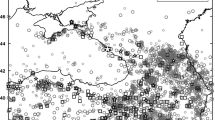Abstract
The Bayesian approach aims to obtain an inference utilizing indirect data as the prior information and direct data (or samples) as the observation. This paper presents a new Bayesian approach to estimate the annual rate of PGA exceedance (or SA: spectral acceleration), based on several sources of indirect data (e.g., ground motion prediction equations, seismic source models, and earthquake catalogs) and the directly recorded PGA data. In addition to the methodology, three case studies in Taiwan were also conducted. Like other Bayesian calculations, the case studies show that the Bayesian estimate is in between the estimate sorely based on the indirect data and the estimate sorely based on the PGA records (direct data), demonstrating the new Bayesian approach for estimating the annual rate of PGA exceedance (also known as seismic hazard) is fundamentally robust.


source model used in a PSHA study for Taipei (Taiwan); the value in the parenthesis is the b-value of the Gutenberg-Richter recurrence law (after Wang et al. 2013)









Similar content being viewed by others
References
Akeju OV, Senetakis K, Wang Y (2019) Bayesian parameter identification and model selection for normalized modulus reduction curves of soils. J Earthquake Eng 23:305–333
Anbazhagan P, Vinod JS, Sitharam TG (2009) Probabilistic seismic hazard analysis of Bangalore. Nat Hazards 48(2):145–166
Ang AHS, Tang WH (2007) Probability concepts in engineering; emphasis on applications to civil and environmental engineering. John Wiley & Sons, New Jersey
Bommer JJ, Scherbaum F (2008) The use and misuse of logic trees in probabilistic seismic hazard analysis. Earthq Spectra 70:165–168
Cao Z, Wang Y (2014) Bayesian model comparison and characterization of undrained shear strength. J Geotech Geoenviron Eng 140(6):04014018
Castanos H, Lomnitz C (2002) PSHA: is it science? Eng Geol 66:315–317
Central Weather Bureau of Taiwan (CWB): https://scweb.cwb.gov.tw/zh-tw/page/disaster/ . (access on 15 Jan 2022)
Cheng CT, Chiou SJ, Lee CT, Tsai YB (2007) Study on probabilistic seismic hazard maps of Taiwan after Chi-Chi earthquake. J GeoEngineering 2:19–28
Ching J, Phoon KK, Chen YC (2010) Reducing shear strength uncertainties in clay by multivariate correlations. Can Geotech J 47(1):16–33
Cornell CA (1968) Engineering seismic risk analysis. Bull Seis Soc Am 58(5):1583–1606
Hapke C, Plant N (2010) Predicting coastal cliff erosion using a Bayesian probabilistic model. Mar Geol 278(1):140–149
Kolathayar S, Sitharam TG (2012) Comprehensive probabilistic seismic hazard analysis of the Andaman-Nicobar Regions. Bull Seis Soc Am 102:2063–2076
Kramer SL (1996) Geotechnical earthquake engineering. Prentice Hall Inc., New Jersey
Krinitzsky EL (2002) Epistematic and aleatory uncertainty: a new shtick for probabilistic seismic hazard analysis. Eng Geol 66:157–157
Lin PS, Lee CT, Cheng CT, Sung CH (2011) Response spectral attenuation relations for shallow crustal earthquakes in Taiwan. Eng Geol 121:150–164
Musson RMW (2012a) PSHA validated by quasi observational means. Seismol Res Lett 83:130–134
Musson RMW (2012b) Probability in PSHA: reply to comment on “PSHA validated by quasi observational means” by Z. Wang Seismol Res Lett 83:717–719
Ng IT, Yuen KV, Lao NK (2016) Probabilistic characterization of cyclic shear modulus reduction for normally to moderately over-consolidated clays. Earthq Eng Eng Vib 15:495–508
Pan YX, Ventura CE, Tannert T (2020) Damage index fragility assessment of low-rise light-frame wood buildings under long duration subduction earthquakes. Struct Saf 84:101940
Petersen MD, Dewey J, Hartzell S, Mueller C, Harmsen S, Frankel A, Rukstales K (2004) Probabilistic seismic hazard analysis for Sumatra, Indonesia and across the Southern Malaysian Peninsula. Tectonophysics 390:141–158
Phoon KK, Kulhawy FH (1999) Characterization of geotechnical variability. Can Geotech J 36(4):612–624
Stirling M, Litchfield N, Gerstenberger M, Clark D, Bradley B, Beavan J, McVerry G, Van Dissen R, Nicol A, Wallace L, Buxton R (2011) Preliminary probabilistic seismic hazard analysis of the CO2CRC Otway project site, Victoria, Australia. Bull Seis Soc Am 101:2726–2736
USNRC (2007) A performance-based approach to define the site-specific earthquake ground motion. Regulatory Guide 1.208. United States Nuclear Regulatory Commission
Wang JP, Chang SC, Xu Y (2016) Best-estimate return period of the Sanchiao fault in Taipei: Bayesian approach. Natural Hazards Review ASCE 17(1):06015001
Wang JP, Huang D, Cheng CT, Shao KS, Wu YC, Chang CW (2013) Seismic hazard analysis for Taipei City including deaggregation, design spectra, and time history with Excel applications. Comput Geosci 52:146–154
Wang JP, Xu Y (2015) Estimating the standard deviation of soil properties with limited samples through the Bayesian approach. Bull Eng Geol Env 74:271–278
Wang JP, Xu Y, Kuochen H, Wu YM (2018) CAV site-effect assessment: a case study of Taipei Basin. Soil Dyn Earthq Eng 108:142–149
Wang JP, Lin YH (2021) Application of Bayesian calculation to determine logic-tree weights for ground motion prediction equations: seismological case studies in Taiwan. Eng Geol 294:106347
Wang Z (2012) Comment on “PSHA validated by quasi observational means” by R.M.W Musson. Seismol Res Lett 83:714–716
Wu MH, Wang JP (2020) Relationship between earthquake magnitude and fault length for Taiwan: Bayesian approach. J GeoEng 15(2):69–76
Wu YM, Shin TC, Chang CH (2001) Neal real-time mapping of peak ground acceleration and peak ground velocity following a strong earthquake. Bull Seis Soc Am 91:1218–1228
Xu Y, Wang JP, Wu YM, Kuochen H (2019) Prediction models and seismic hazard assessment: a case study from Taiwan. Soil Dyn Earthq Eng 122:94–106
Acknowledgements
The authors appreciate the editors and reviewers for their constructive comments, improving the paper in so many aspects
Author information
Authors and Affiliations
Corresponding author
Rights and permissions
About this article
Cite this article
Wang, J.P., Sung, CY. & Chang, SC. Bayesian seismic hazard analysis. Bull Eng Geol Environ 81, 265 (2022). https://doi.org/10.1007/s10064-022-02768-y
Received:
Accepted:
Published:
DOI: https://doi.org/10.1007/s10064-022-02768-y




